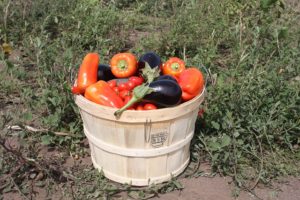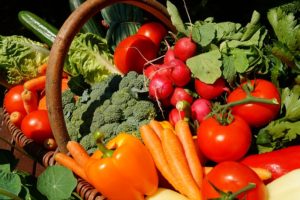 Do you or someone you love suffer from the pain of stiff and swollen joints, known as arthritis?
Do you or someone you love suffer from the pain of stiff and swollen joints, known as arthritis?
Get ready for some good news!
When it comes to a disease for which changing your diet provides improvements you can actually FEEL…this is it!
First of all, why do some suffer from arthritis?
 Arthritis is an inflammation of the joints, and can affect one joint or multiple joints. There are actually more than 100 types of arthritis, but the two most common are osteoarthritis and rheumatoid arthritis. The symptoms of arthritis typically develop over time in adults over the age of 65, but can also come on suddenly and be found in children, teens and younger adults.
Arthritis is an inflammation of the joints, and can affect one joint or multiple joints. There are actually more than 100 types of arthritis, but the two most common are osteoarthritis and rheumatoid arthritis. The symptoms of arthritis typically develop over time in adults over the age of 65, but can also come on suddenly and be found in children, teens and younger adults.
The most common symptoms of arthritis are joint pain, stiffness and swelling. People who suffer from rheumatoid arthritis can even experience fatigue and lack of appetite because of inflammation in their immune system.
Quick biology class flashback! Remember, cartilage is the firm, but flexible, tissue in our joints and it protects our joints by absorbing the pressure and stress we put on them. Wear and tear, injury or infection can cause our cartilage to deteriorate, resulting in some forms of arthritis. Rheumatoid arthritis, on the other hand, is considered an autoimmune disorder because our body’s immune system actually attacks the tissues of the body. This affects the soft tissue in our joints, specifically the production of fluid that protects the cartilage and lubricates the joints.
What can you do to help fight arthritis?
The main goal of treating arthritis is to ease the pain and prevent additional damage to the joints. Of course, there are medications, surgery and physical therapy options, but there are also important lifestyle changes that can dramatically improve arthritis symptoms.
EASING INFLAMMATION is the name of the game. It’s a fact that our Standard American Diet (“the SAD diet”) is notorious for stoking the flames of inflammation. However, when you know what foods to add and what to take away, you can make your home and eating lifestyle a “health haven for pain reduction!”
So, let’s start out simple, with things you are likely already doing, then ramping up to strategies you may not be doing. We hope this plan will give you the inspiration and motivation to do any necessary pantry clean-out and restocking you need to do to give the anti-inflammatory diet a serious try and really feel the difference! And then, along with the numerous recipes on Eat REAL America, you are home free!
What foods promote inflammation and should be avoided?
This will come as no surprise that it’s best to avoid these foods or at least enjoy them in extreme moderation:
- Refined sugar including sugary beverages, cakes, pies, cookies, candy and cereals. Refined sugar tells your body to release chemicals called cytokines that kick-start the inflammation process, while also packing on calories making needed weight control difficult. Note: this does NOT include fruit! Fruit is naturally high in potassium, fiber and other beneficial, anti-inflammatory nutrients.
- Fried foods. The high temperatures used when frying food raise the level of advanced glycation end products (or AGE’s in your blood). These increased levels lead to inflammation, which causes joint pain, not to mention packing on the calories and aiding in weight gain.
- Highly processed foods. Avoid those fake, food-like substances found at the store that make you feel like you need a chemistry degree to understand the ingredient label. These include foods with MSG, additives, food colorings, added sugars, high sodium (which increases swelling and joint point) and preservatives. You know the ones…bottled salad dressings, lean hot pockets and frozen pizzas, just to name a few.
- Processed meats. This is a sodium landmine that can really sneak up on you…you can consume a lot of processed meat each day without even realizing it. Check out our coaching tip on how to reduce your intake and ideas for substitutions!
Add these foods to help put out the fire of inflammation!
 Bountiful leafy greens and a variety of vegetables — for every meal and snack! Potassium-rich foods boost anti-inflammatory properties in the body, so make sure to include foods such as spinach, kale, sweet potatoes, avocados, beans and beets, as well as bananas and oranges, just to name a few! Our Everyday Hummus is a great way to get some extra potassium and enjoy a variety of fresh veggies. Plus, check out our vegetarian meals and snack ideas!
Bountiful leafy greens and a variety of vegetables — for every meal and snack! Potassium-rich foods boost anti-inflammatory properties in the body, so make sure to include foods such as spinach, kale, sweet potatoes, avocados, beans and beets, as well as bananas and oranges, just to name a few! Our Everyday Hummus is a great way to get some extra potassium and enjoy a variety of fresh veggies. Plus, check out our vegetarian meals and snack ideas!- Load up on omega 3’s! See our coaching tip for the many ways to include these “key inflammation dousers” called omega 3’s in your meals with salmon, tuna, grass-fed beef, and even chia seeds and flax seeds.
 The Mediterraneans are onto something! Including a variety of nuts, olives and olive oil are extremely beneficial – it can be as simple as the Easy Greek Salad or add some pizzazz to dinnertime with Zoodles Gone Mediterranean or Greek Style Quinoa Bowl.
The Mediterraneans are onto something! Including a variety of nuts, olives and olive oil are extremely beneficial – it can be as simple as the Easy Greek Salad or add some pizzazz to dinnertime with Zoodles Gone Mediterranean or Greek Style Quinoa Bowl.- Spice it up! Using a variety of spices daily will not only help your meals burst with flavor, but turmeric and ginger are a couple of superstars when it comes to reducing inflammation…have you tried the Turmeric Latte yet?
No Grain, No Pain? What about gluten?
 Some research suggests that a gluten-free diet may improve arthritis symptoms and disease progression. This 2015 study recommends a gluten-free diet for all people who receive any kind of diagnosis of undifferentiated connective tissue disease. Are you thinking…what, I can’t live without bread?! While no one wants to eliminate foods they don’t have to, if you have arthritis, it may be worth a try.
Some research suggests that a gluten-free diet may improve arthritis symptoms and disease progression. This 2015 study recommends a gluten-free diet for all people who receive any kind of diagnosis of undifferentiated connective tissue disease. Are you thinking…what, I can’t live without bread?! While no one wants to eliminate foods they don’t have to, if you have arthritis, it may be worth a try.
Gluten is found in wheat, rye and barley, and not in rice, corn, quinoa and potatoes. We make living gluten-free as easy as possible with MANY gluten-free options, and our Eat REAL Cookbook is gluten friendly (recipes are either naturally gluten-free or we give you the gluten-free option). Learn more about going gluten-free in our coaching tip.
Dairy: Friend or Foe?
 Some studies show dairy foods decrease inflammation. Others show they increase inflammation. Despite conflicting information, a 2017 review of 52 clinical studies, published in Critical Reviews in Food Science and Nutrition, concluded that dairy generally has anti-inflammatory effects, except in people allergic to cow’s milk.
Some studies show dairy foods decrease inflammation. Others show they increase inflammation. Despite conflicting information, a 2017 review of 52 clinical studies, published in Critical Reviews in Food Science and Nutrition, concluded that dairy generally has anti-inflammatory effects, except in people allergic to cow’s milk.
Then the question is…are you allergic to cow’s milk or have a sensitivity to it? Sensitivities are not always obvious, so you might try giving up dairy for 30 days. You will learn a lot. You will realize you really don’t need cheese on everything! And nut milk options are delicious! We’re confident you will discover if limiting your dairy intake is best for you!
What about “nightshade” vegetables?
 Nightshades are a family of flowering plants called Solanaceae. They include white potatoes, tomatoes, eggplant and bell peppers. These veggies include compounds known as alkaloids. While these offer health benefits to most people, it is thought that some people with arthritis suffer from an allergy or intolerance to alkaloids. Therefore, many with arthritis say avoiding nightshade vegetables helps them feel better.
Nightshades are a family of flowering plants called Solanaceae. They include white potatoes, tomatoes, eggplant and bell peppers. These veggies include compounds known as alkaloids. While these offer health benefits to most people, it is thought that some people with arthritis suffer from an allergy or intolerance to alkaloids. Therefore, many with arthritis say avoiding nightshade vegetables helps them feel better.
Stay tuned for next week’s coaching tip where we will dive more into further understanding nightshade vegetables, and if you decide to try giving them up, we will offer good substitutions so you don’t miss them!
Putting it all together!
In addition to giving up processed food, living a “vegetable forward” lifestyle, getting plenty of sleep and managing your stress, we hope we’ve given you powerful ideas to further decrease inflammation and pain.
Go ahead and try removing gluten, dairy and “night-shade” vegetables for at least 30 days, while keeping a food log (with a corresponding column for how you feel is most helpful). Keep in mind that lack of sleep, stress and physical exertion are all things that can also affect your joint pain, so be sure to keep those factors consistent while you are evaluating improvements in pain levels. Then, assuming you feel better, you can consider adding them back one at a time (just the dairy, the gluten, and/or nightshades).
Find what works best for you!
We hope knowing this information gives you new power, to take control of your health or help someone you love!
Sources:
https://www.webmd.com/rheumatoid-arthritis/ra-foods#3
https://www.ncbi.nlm.nih.gov/pubmed/25583468
https://blog.arthritis.org/living-with-arthritis/nightshades-arthritis/
https://www.medicalnewstoday.com/articles/321883.php




Can I eat nightshades if I don’t have an allergy? Or they are harmful anyway?
Richard – Thank you for asking! Our follow up coaching tip to this one may shed some light and answer some of your questions about nightshade vegetables, it is called “Should You Avoid Nightshade Vegetables?”. If you are not experiencing any allergies or sensitivities, then you should be fine to enjoy nightshade vegetables. Some people lack the enzymes to properly digest the compounds in nightshade vegetables. I hope that helps! Thank you again!